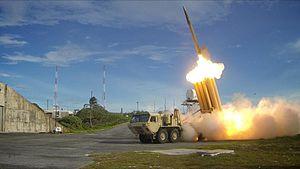Ballistic Missile Defence, Diplomacy, and North Korea

See The Simons Foundation's page on The Canadian Defence Policy Review for briefing papers by Ernie Regehr, O.C., Senior Fellow in Defence Policy and Arctic Security at The Simons Foundation.
Ballistic Missile Defence, Diplomacy, and North Korea
To South Koreans well within the firing range of a regime and leader of dubious stability and demeanour, it might seem eminently sensible to pursue protection from Kim Jong-un’s brandished missiles and nuclear warheads, but those same South Koreans are far from united on hosting American missile defence batteries on their soil. Indeed, they’ve just elected the presidential candidate most critical of the rushed THAAD (Terminal High Altitude Area Defense) deployment. Whether the new Government revives an all-out “Sunshine Policy” of re-engagement with the North, it should find missile defence a poor substitute for diplomacy.
The forces of Kim Jong-un of North Korea do not now have the capacity to fire nuclear-tipped intercontinental ballistic missiles (ICBMs) on North America (nor, by the way, does or will the US have the capacity to reliably intercept such an attack). So, for now, those most immediately vulnerable to Pyongyang’s missiles are the Japanese and South Koreans. As close neighbors of North Korea, they are well aware there is no sure-fire military protection from either its conventional or emerging nuclear threat – but, that said, three separate missile defence systems (Aegis, THAAD, and PAC-3) are now deployed in the region.
The American Aegis (the shield of Zeus, no less) is a ship-based combat system first deployed in 1983. It was given ballistic missile defence (BMD) capabilities through software upgrades, new interceptor missiles, and sensors to guide interceptors to target aircraft- and ship-borne (surface and sub-surface) attack missiles. As with all missile defence systems, it relies on satellites to detect missile launches, which land- and sea-based radars then track to guide the Aegis interceptors to mid-course, exo-atmospheric interceptions. The interceptors rely on non-explosive warheads to collide with and destroy the oncoming warheads.
As of December 2014, according to the Pentagon’s Missile Defense Agency (MDA), the US had five cruisers and 28 destroyers equipped as Aegis BMD combatants – and of those 33 ships, 16 were in the Pacific. Japan is operating the Aegis BMD system on four of its KONGO class destroyers and South Korea has cruisers with Aegis tracking capabilities, but not interceptors. The same system is used by NATO in Europe – with some of the interceptors land-based.
The Terminal High Altitude Area Defence (THAAD) system has just been deployed in South Korea. It is land-based, mobile, and designed to intercept oncoming warheads in their final descent – in the last stages of space flight or within the atmosphere. It has four basic elements: a radar to locate and track an oncoming missile, truck mounted launchers that fire the interceptor missiles (eight per truck), a command and control system, and the interceptors, also tipped with kinetic hit-to-kill warheads that are to collide with an oncoming missile. The system was first activated in the US in 2008 but has not seen combat. In addition to the current deployment in South Korea, the THAAD system was deployed in Guam in 2013.
PAC batteries (the US Army’s Patriot Advanced Capability interceptors, operating within the atmosphere) are deployed on military bases in the region. These are air- and missile-defence interceptors designed to protect local forces from short-range attacks.
These regional systems rely on the X-band AN/TPY-2 radar to track warheads, discriminate between warheads and decoys, and send updated data to the interceptors. While radars operating in north Asia on land and at sea (the latter on a self-propelled ocean-going platform) serve regional interceptors, they also pass along tracking data relevant to strategic-range BMD command and control elements, which is at the core of China’s concerns about THAAD deployments in the region.
Just how much protection THAAD offers is debated. The US Department of Defense (DOD) points to 36 exo-atmospheric intercept attempts, of which 29 were rated a success. There have been 6 tests of endo-atmospheric intercepts, all of which were rated successful. That makes 42 regional BMD interception tests, of which 35 were successful. But the tests were not conducted under realistic conditions. George Lewis and Ted Postol, two noted BMD experts and critics based at the Massachusetts Institute of Technology, say their independent analysis suggests that in combat most of the “successful” interceptions would in fact have failed to destroy the attacking warheads. Continue reading...
Ernie Regehr, O.C. is Senior Fellow in Defence Policy and Arctic Security at The Simons Foundation, and Research Fellow at the Centre for Peace Advancement, Conrad Grebel University College, University of Waterloo.